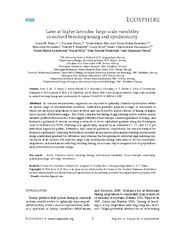| dc.contributor.author | Burr, Zofia M. | |
| dc.contributor.author | Varpe, Øystein | |
| dc.contributor.author | Anker-Nilssen, Tycho | |
| dc.contributor.author | Erikstad, Kjell E | |
| dc.contributor.author | Descamps, Sébastien | |
| dc.contributor.author | Barrett, Robert T. | |
| dc.contributor.author | Bech, Claus | |
| dc.contributor.author | Christensen-Dalsgaard, Signe | |
| dc.contributor.author | Lorentsen, Svein-Håkon | |
| dc.contributor.author | Moe, Børge | |
| dc.contributor.author | Reiertsen, Tone Kristin | |
| dc.contributor.author | Strøm, Hallvard | |
| dc.date.accessioned | 2016-08-31T06:28:13Z | |
| dc.date.available | 2016-08-31T06:28:13Z | |
| dc.date.issued | 2016-05-28 | |
| dc.description.abstract | In seasonal environments, organisms are expected to optimally schedule reproduction within an annual range of environmental conditions. Latitudinal gradients generate a range of seasonality to which we can expect adaptations to have evolved, and can be used to explore drivers of timing strategies across species’ distribution ranges. This study compares the timing of egg hatching in four seabird species (Atlantic puffin Fratercula arctica, black-legged kittiwake Rissa tridactyla, common guillemot Uria aalge, and Brünnich's guillemot U. lomvia) covering a subarctic to Arctic latitudinal gradient along the Norwegian coast to Svalbard (65–79°N). Hatching was significantly delayed by an estimated 1.7, 2.3, and 1.9 d per latitudinal degree for puffins, kittiwakes, and common guillemots, respectively, but was not delayed for Brünnich's guillemots. Hatching distributions revealed an increase in intra-annual breeding synchronicity along a latitudinal gradient for kittiwakes only, whereas the two guillemots exhibited high hatching synchronicity at all colonies. We used this large-scale, multispecies timing data series to discuss constraints, adaptations, and mechanisms affecting breeding timing, a necessary step to recognize risks to populations and predict future ecosystem change. | en_US |
| dc.description.sponsorship | This research was made possible by the SEAPOP (SEAbird POPulations) program of Norway, and the many involved with the data collection. We thank the Fram Centre for their support and incentive funds to develop the later stages of the work, and an anonymous reviewer for valuable comments. | en_US |
| dc.description | Publisher's version, source: <a href=http://doi.org/10.1002/ecs2.1283>http://doi.org/10.1002/ecs2.1283</a>. | en_US |
| dc.identifier.citation | Ecosphere 2016, 7(5) | en_US |
| dc.identifier.cristinID | FRIDAID 1359716 | |
| dc.identifier.doi | 10.1002/ecs2.1283 | |
| dc.identifier.issn | 2150-8925 | |
| dc.identifier.uri | https://hdl.handle.net/10037/9596 | |
| dc.identifier.urn | URN:NBN:no-uit_munin_9154 | |
| dc.language.iso | eng | en_US |
| dc.publisher | Ecological Society of America | en_US |
| dc.relation.projectID | Andre: SEAPOP | |
| dc.relation.projectID | Andre: Fram Centre | |
| dc.rights.accessRights | openAccess | |
| dc.subject | VDP::Matematikk og Naturvitenskap: 400::Zoologiske og botaniske fag: 480::Økologi: 488 | en_US |
| dc.subject | Arctic | en_US |
| dc.subject | Fratercula arctica | en_US |
| dc.subject | hatching timing | en_US |
| dc.subject | inter-annual variability | en_US |
| dc.subject | Rissa tridactyla | en_US |
| dc.subject | seasonality | en_US |
| dc.subject | spatial phenology | en_US |
| dc.subject | Uria aalge | en_US |
| dc.subject | Uria lomvia | en_US |
| dc.title | Later at higher latitudes: large-scale variability in seabird breeding timing and synchronicity | en_US |
| dc.type | Journal article | en_US |
| dc.type | Tidsskriftartikkel | en_US |
| dc.type | Peer reviewed | en_US |


 English
English norsk
norsk